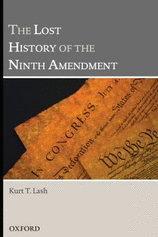 He applied the “Page 99 Test” to his new book, The Lost History of the Ninth Amendment, and reported the following:
He applied the “Page 99 Test” to his new book, The Lost History of the Ninth Amendment, and reported the following:It is a pleasure to talk about the 99th page in my new book, The Lost History of the Ninth Amendment (Oxford University Press, 2009). The book presents newly uncovered evidence which suggests the Ninth Amendment originally was understood as working alongside the Tenth Amendment as a rule of construction calling for a narrow construction of federal power. The 99th page of the book comes from a chapter which explains how this rule of narrow or strict construction was presumed to inform all powers delegated to the federal government—including powers delegated to the federal courts in Article III of the Constitution. This particular page explores how the rule came up during the original debates over the meaning of Article III in the Virginia Ratification Convention:Read more about the book at the Oxford University Press website.
Anti-federalists were quick to point out the danger lurking behind the words of Article III. In the Virginia Convention, for example, George Mason warned that Article III would allow the “sovereignty of the state to be arraigned like a culprit, or private offender.” The response of Federalist advocates of the Constitution was the same on this matter as it was in regard to other texts whose construction appeared to threaten the retained sovereignty of the states: The text would be narrowly construed in order to the preserve the independent sovereign existence of the states. James Madison, for example, conceded the wording of Article III “does not stand in that form which would be freest from objection. It might be better expressed.” Nevertheless, Madison insisted that:
It is not in the power of individuals to call any state into court. The only operation it can have, is that, if a state should wish to bring a suit against a citizen, it must be brought before the federal court.... It appears to me that this can have no operation but this--to give a citizen a right to be heard in the federal courts; and if a state should condescend to be a party, this court may take cognizance of it.
This is a straight forward example of strict construction: The operational meaning of a term otherwise capable of a broad interpretation is narrowed in order to preserve the presumed sovereign status of the states. Although the text allows federal courts to hear suits between states and individuals, this applied only where a state was a plaintiff or where it had otherwise consented to be sued by an individual.
Despite the assurances of Federalists like James Madison and John Marshall that federal power would be narrowly construed in order to preserve the retained sovereign powers and rights of the people in the states, it appeared that the Constitution would not be ratified unless these assurances were made an express part of the Constitution. Ultimately, Federalist proponents of the Constitution agreed to add a Bill of Rights to the ratified Constitution. What we now call the Ninth and Tenth Amendments were specifically added to ensure a state-protective reading of federal power.
Within months of the ratification of the Constitution, however, nationalists like Alexander Hamilton pressed for the creation of a National Bank—an act which Madison insisted was beyond the scope of delegated federal power. The following passage, which describes Madison’s reaction to the proposed Bank is from pages 39-40 of the book:
Madison emphatically disagreed. The broad construction of federal power relied upon by the Bank’s advocates threatened the retained power and rights of the people. In his speech before the House, Madison reminded the Assembly of the recent struggle to ratify the Constitution and how the state ratifying conventions had been promised a federal government of limited power. The states had ratified the Constitution, but had done so on the understanding that the delegated powers of government would be narrowly construed and most had demanded the addition of amendments that would make this understanding an express part of the Constitution. Madison referred the House to the pending Bill of Rights as fulfilling the promise that federal power would receive a limited construction.
The explanatory amendments proposed by Congress themselves, at least, would be good authority with [the state proposals]; all these renunciations of power proceeded on a rule of construction, excluding the latitude now contended for. These explanations were the more to be respected, as they had not only been proposed by Congress, but ratified by nearly three-fourths of the states. He read several of the articles proposed, remarking particularly on the 11th and 12th. The former, as guarding against a latitude of interpretation—the latter, as excluding every source of power not within the constitution itself.
Here Madison explains that the Tenth Amendment “exclud[ed] every source of power not within the constitution itself,” while the Ninth Amendment “guard[ed] against a latitude of interpretation” of those powers which were in the Constitution. He referred to these amendments, however, not as the Ninth and Tenth, but as the “11th and 12th.” This reflected an early practice of referring to the amendments according to their original place on a list of twelve proposed amendments—only ten were ratified at the time and what we call the Ninth and Tenth were the eleventh and twelfth on that list. This is just one example of early references to the Ninth that, until very recently, went unnoticed. They form an important part of what I call the Lost History of the Ninth Amendment.
--Marshal Zeringue



